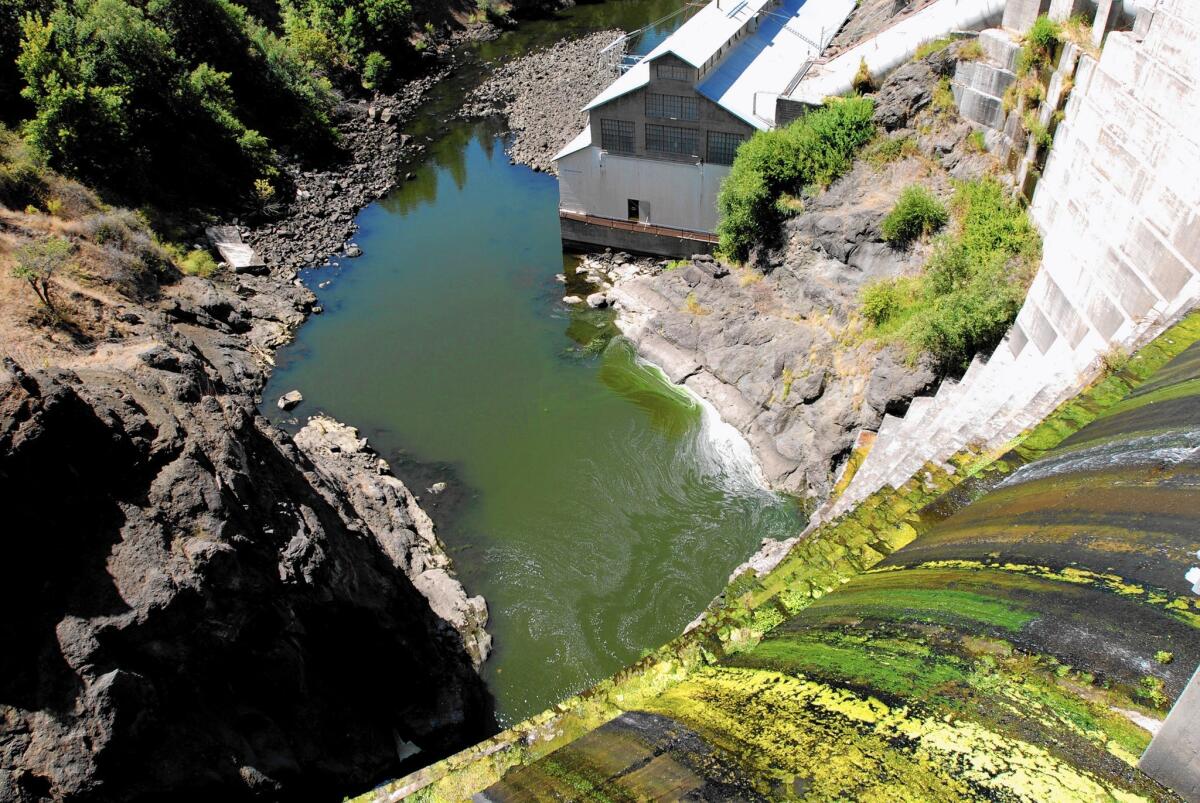Demise of Klamath River deal could rekindle old water-use battles

The demise of a deal to end decades of feuding on the Klamath River could rekindle old battles over water use and dams in a remote corner of California.
A key piece of a three-part agreement expired when Congress failed to approve it by Dec. 31. The complicated pact, backed by the states of California and Oregon, called for the removal of four hydroelectric dams, settled water rights disputes and spelled out water allocations for irrigators and wildlife refuges in the Klamath Basin.
But the deal never got traction in the GOP-dominated Congress. And though some backers are holding out hope that it can be resurrected, others are doubtful.
NEWSLETTER: Get the dayâs top headlines from Times Editor Davan Maharaj >>
âIt would be very difficult if not impossible to pull the same parties to the table and reach a similar agreement,â said Don Gentry, chairman of Oregonâs Klamath Tribes.
Conflict over the Klamath embodies classic struggles over western water.
Tribes, farmers, hydropower interests and commercial fishermen all have fought over the 255-mile river, which winds from southern Oregon through Northern California to the Pacific Ocean. Dams, farm and ranch diversions and agricultural runoff have exacted a heavy toll on a waterway that once supported Chinook salmon runs half a million strong.
It would be very difficult if not impossible to pull the same parties to the table and reach a similar agreement.
— Don Gentry, chairman of Oregonâs Klamath Tribes
The clashes drew national attention in 2001, a dry year when the federal government cut irrigation deliveries to preserve fish flows.
Enraged farmers threatened to open irrigation gates by force. The following year, the government increased irrigation deliveries â triggering lethal river conditions that left more than 30,000 dead salmon and steelhead trout floating in the lower Klamath.
The agreements, signed in 2010 and expanded in 2014, were supposed to end the strife. But they didnât please everyone.
Californiaâs Siskiyou County, where three of the utility company dams are located, opposed their removal, as did key Republican congressmen. Environmentalists and some tribes complained that the pact gave too much water to irrigators and too little to salmon.
Attorney Tom Schlosser, who represents Californiaâs Hoopa Valley Tribe, called the expiration âgood news.â
âIâm so tired of hearing this story.... We all sang âKumbayaâ and Congress didnât pay any attention,â Schlosser said, âwhen actually the Congress did exactly what it should have done. They looked at this and said, âThis is a non-starter.âââ
The Hoopa, he said, will press ahead for dam removal through the federal dam relicensing process, which was put on the back burner when the agreements were struck. Californiaâs Yurok Tribe, which withdrew from the accord last year, also has indicated it will keep pushing to get rid of the dams.
Other groups could head back to court to settle lingering water rights disputes between the Klamath Tribes and farmers. âParties are going to start doing some of their own things,â said Greg Addington of the Klamath Water Users Assn., a group of irrigation districts supplied by the federal Klamath Project.
âIâm not saying itâs over,â Addington said of attempts to save the accord. But Congress would have to signal more interest before his group makes another big push for the settlement. âWeâre not just going to go beat our head against the wall again,â he said.
The U.S. Interior Department, which oversees federal irrigation operations and wildlife refuges in the basin, supported the Klamath deal. âWe still believe the future of the basin lies with negotiated agreements, and we will work hard with the parties to find ways to achieve their collective goals,â Interior Secretary Sally Jewel said in a statement.
The dams, spread across 65 miles of the Klamath, are owned by PacifiCorp, a part of Warren Buffettâs Berkshire Hathaway Inc. empire.
Under the pact, the company had until 2020 to remove the structures, the oldest of which was erected in 1918. The dams block historic salmon spawning grounds on the upper river and create stagnant pools of water that breed toxin-producing algae.
The agreements called for California to help pay for the dam removal and granted PacifiCorp immunity from any liability claims that arose from decommissioning.
Join the conversation on Facebook >>
Without the Klamath agreements, PacifiCorp faces a lengthy dam relicensing process and requirements to meet California water quality standards that could force it to spend an estimated $400 million on fish ladders and other improvements.
âWeâre all just waiting to see whether thereâs any desire among the congressional delegation, the administration and the settlement partners to try to resurrect the agreements we made,â said PacifiCorp spokesman Bob Gravely. âWe donât know exactly how that would happen or what it would look like.â
Twitter: @boxall
ALSO
In Oregon standoff, local sheriff embraces the spectacle
âEl Chapoâ could have fled to another continent, but he chose to go home
Supreme Court weighs union fees for teachers: Is it a matter of free speech?







